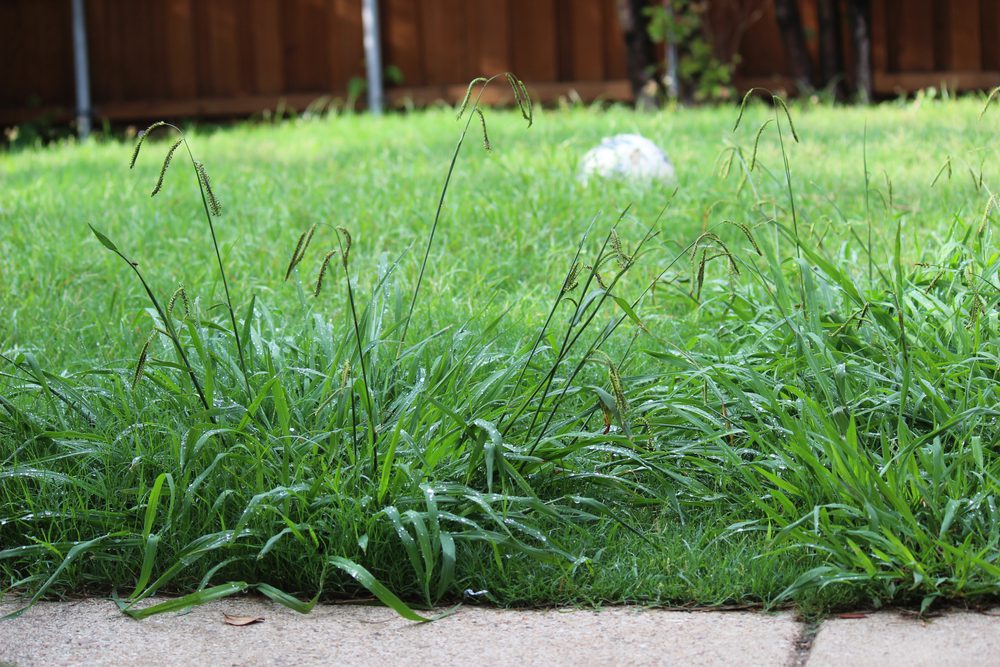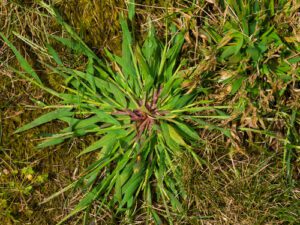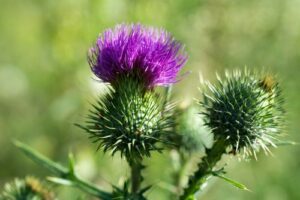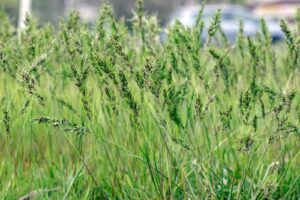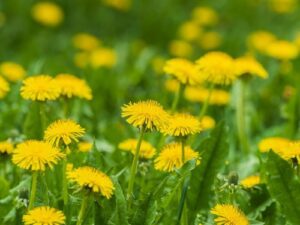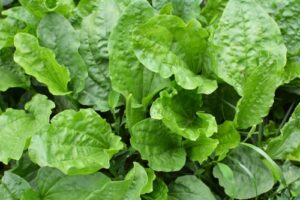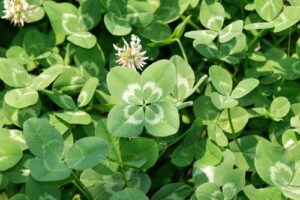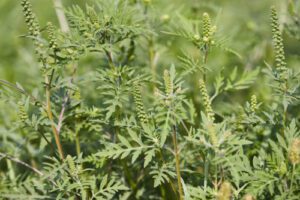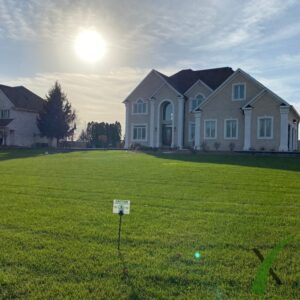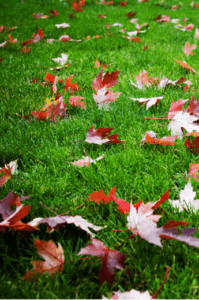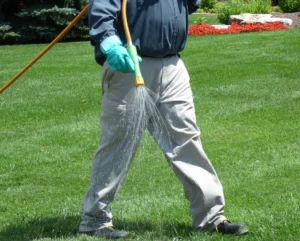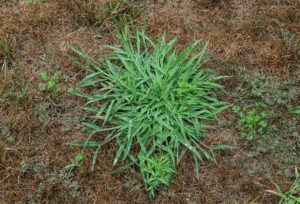Lawn weeds can sprout up in lawns, gardens, and pavement cracks, posing threats to your landscape’s aesthetic and health. While common lawn weeds are relatively harmless, some can spread rapidly if left untreated, choking out desired plants by stealing their space and nutrients.
In this blog, we’ll review some of the most common lawn weeds found in residential areas and provide tips on identifying and eliminating these unwanted invaders.
Crabgrass
Crabgrass is an intrusive, opportunistic lawn weed that flourishes in areas with bare soil and exposure to sunlight. It is characterized by clumpy growth and wide, flat blades.
- Plant Type: Warm-season annual, in the grass family
- Danger: Low; crabgrass won’t actually harm your lawn, but it grows in unsightly clumps that may detract from the look of your manicured turf grass.
- Habitat: Dry, exposed soil
- How to Get Rid of Crabgrass: The best way to get rid of crabgrass is to prevent its spread in the first place. Since it is a summer annual, you can prevent it by seeding infected areas in the fall and again at the beginning of spring. If you find yourself in a situation where you have to manage existing crabgrass growth, hand-pulling young crabgrass is your best bet because younger weeds leave behind smaller holes for the weed seeds to fill.
Bull Thistle
Bull thistle is characterized by its purple flowers and thorny spines. It can spread quickly and its seeds remain viable in the soil for years, posing persistent challenges for lawn care and maintenance.
- Plant Type: Biennial herbaceous plant
- Danger: Low to moderate; its sharp spines can sting upon contact
- Habitat: Moist and dry soil, typically found in disturbed areas or cultivated land
- How to Get Rid of Bull Thistle: Treat the infected area with a post-emergent herbicide in the spring. You may also be able to control smaller infestations of bull thistle by digging and hand-pulling. Regular mowing will also prevent the flowering and seeding of bull thistle.
Annual Bluegrass
Annual Bluegrass is one of the most common lawn weeds and can grow up to eight inches if unmowed. Its leaves are narrow and light-green and it produces clusters of green or purplish flowers.
- Plant Type: Cool-season annual, in the grass family
- Danger: Low
- Habitat: Moist, fertile soil like lawns and gardens or vacant lots. It is most abundant in spring
- How to Get Rid of Annual Bluegrass: To control existing annual bluegrass, apply a post-emergent herbicide or physically remove the weeds by hand-pulling them. Then overseed the area with grass varieties of your choice. You might also consider applying a pre-emergent herbicide in the Fall to prevent future seeds from germinating.
Dandelion
Dandelions typically bloom in the Spring and Summer and are characterized by feathery, yellow flowers. They can produce seeds without pollination and commonly invade lawns and nurseries.
- Plant Type: Herbaceous perennial flowering plant
- Danger: Low
- Habitat: Dandelions have adapted to grow in a variety of different environments and conditions,
- How to Get Rid of Dandelions: Dandelions are anchored in the ground by deep taproots that make them difficult to pull by hand, so try to dig deep enough to get a large portion of this taproot. If using a herbicide, use a post-emergent herbicide that will destroy the taproot.
Clover Grass
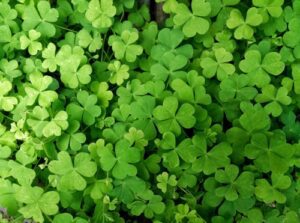
Clovers are characterized by their green, three-lobed, “shamrock-shaped” leaflets, which sometimes have a crescent shape on their upper side. It can tolerate full sun or partial shade.
- Plant Type: Legume
- Danger: Low
- Habitat: Temperate regions, typically grows best in moist climates. It is commonly found in meadows, wooded areas, and lawns.
- How to Get Rid of Clover Grass: Considered an invasive plant in some U.S. states, clover grass can be treated with a broadleaf herbicide. Select an herbicide that is formulated specifically for clover.
Plantain Lawn Weeds
Plantain lawn weeds are durable, broadleaf weeds with leaves arranged in a rosette pattern. They have flowers that grow in spikes which can grow up to 10 inches high.
- Plant Type: Herbaceous perennial
- Danger: Low; can reduce the integrity of desirable plants.
- Habitat: Plantain weeds grow well in compacted soils that have been disturbed by human activity. It is commonly found along roads, in pastures, and lawns.
- How to Get Rid of Plantain Lawn Weeds: Treat plantain weeds with a post-emergent herbicide before they flower. Otherwise, they are more susceptible to spreading.
Chickweed
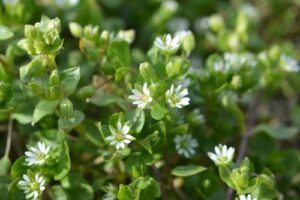
Characterized by its white, star-shaped flowers, chickweed is a resilient weed that grows in clusters close to the ground.
- Plant Type: Depending on the region, chickweed is a broadleaf annual or perennial
- Danger: Low; it is edible and especially enjoyed by chickens
- Habitat: Chickweed begins to grow in the winter and can tolerate low temperatures. It enjoys shaded areas and moist, disturbed soils.
- How to Get Rid of Chickweed: Chickweed has shallow roots that can be removed by hand. If using an herbicide, employ a pre-emergent broadleaf herbicide in early spring.
Creeping Charlie
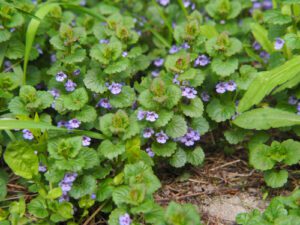
As its name suggests, creeping Charlie is an aggressive plant that can quickly invade your lawn. It exudes a minty fragrance and is characterized by clusters of purplish flowers.
- Plant Type: Broadleaf perennial
- Danger: Moderate; if not treated early, creeping Charlie can take over your lawn and steal nutrients from your grass and other plants.
- Habitat: Creeping Charlie grows best in moist soil and areas with shade.
- How to Get Rid of Creeping Charlie: Creeping Charlie can be treated by a combination of techniques such as increased sunlight exposure, lawn fertilizer, and the application of a post-emergent broadleaf herbicide, ideally in the spring or fall.
White Clover Lawn Weeds
Like clover grass, white clover has three-lobed leaves. Unlike clover grass, it develops round, white flower heads in the summer and is therefore easy to spot.
- Plant Type: Broadleaf perennial
- Danger: Low to moderate; attracts pollinators like bees
- Habitat: White clover prefers soil with low nitrogen and is commonly found in fields, lawns, parks, and moderately trafficked woodland paths.
- How to Get Rid of White Clover Lawn Weeds: Since it prefers soil with low nitrogen, you can prevent the growth of white clover by maintaining nutrients in well-fertilized soil. If you find yourself in a position where you have to manage its growth, apply an iron-based herbicide.
Velvetleaf Weeds
Velvet leaf is characterized by its robust, heart-shaped leaves. It reproduces through seed dispersal, and its seeds can remain viable for decades.
- Plant Type: Annual
- Danger: Moderate; it is non-toxic but can invade orchards and crop fields
- Habitat: It is commonly found in cultivated areas like orchards, corn fields, and soybean fields. Its seeds germinate in warmer weather.
- How to Get Rid of Velvet Leaf Weeds: Velvet leaf can be removed by hand-pulling or hoeing. Make sure to remove the entire root system. Dispose of seeds since they can remain viable for a long period.
Annual Ragweeds
Ragweed is characterized by its long, yellow flowers and straight stems. It contains high amounts of pollen and poses a severe threat to allergy sufferers.
- Plant Type: Broadleaf annual
- Danger: Moderate to high; it releases pollen which commonly causes allergic reactions such as sneezing and irritation
- Habitat: Grows in disturbed areas with nutrient-poor, dense soil
- How to Get Rid of Ragweed: Ragweed growth can be prevented by adding compost to your soil. If existing growth needs to be managed, apply a post-emergent broadleaf herbicide in spring or early summer.
Get Personalized Lawn Care with ExperiGreen
ExperiGreen offers a comprehensive lawn fertilization service and weed control program to help you deal with the threats posed by these common lawn weeds. Our solutions are tailored to meet your lawn’s unique needs.
Our lawn programs include pre- and post-emergent weed control, season-long fertilization applications, superior weed prevention in the spring, and more, with up to 12 visits per year.
We also offer additional services as necessary. Contact us today, and get ready to see real results!

